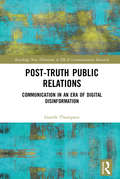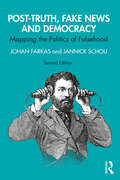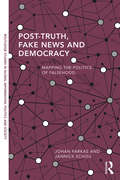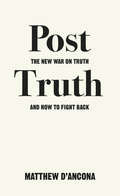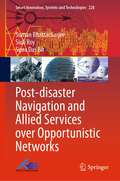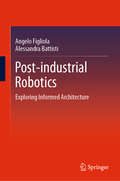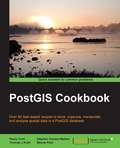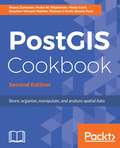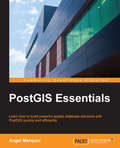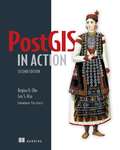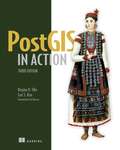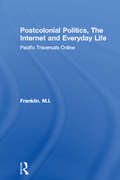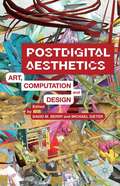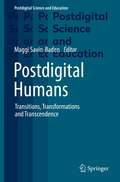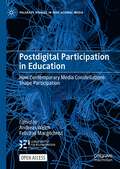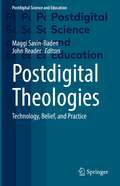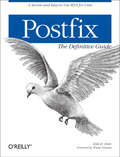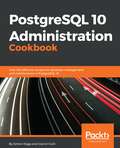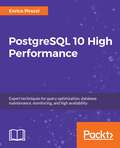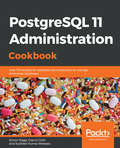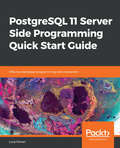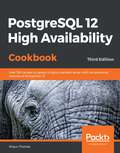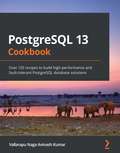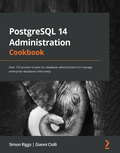- Table View
- List View
Post-Truth Public Relations: Communication in an Era of Digital Disinformation (Routledge New Directions in PR & Communication Research)
by Gareth ThompsonThis book explores the purpose, practice and effects of public relations (PR) at a time that has been variously described as an era of populism, post-truth and fake news. It considers how PR processes have contributed to the current social condition of post-truth and what constitutes PR work in this environment. Post-Truth Public Relations: Communication in an Era of Digital Disinformation proposes that while we can now look back upon the last 80–100 years as a period of classical PR, that style is being supplemented by the emergence of a post-classical form of PR that has emerged in response to the post-truth era. This new style of PR consists of a mixed repertoire of communicative work that matches the new geometry of digital media and delivers a mix of online engagement and persuasion in order to meet the needs of increasingly partisan audiences. Using contemporary case studies and original interviews with PR practitioners in several countries, including China and the Philippines, the book investigates how PR workers have reconciled their role as communicative intermediaries with the post-truth era of digital disinformation. This thought-provoking book will be of great interest to researchers and advanced students interested in the changing nature of PR and its practice.
Post-Truth, Fake News and Democracy: Mapping the Politics of Falsehood (Routledge Studies In Global Information, Politics And Society Ser.)
by Jannick Schou Johan FarkasThe new edition of Post-Truth, Fake News and Democracy offers an updated overview and critical discussion of contemporary discourses around truth, misinformation, and democracy, while also mapping cutting-edge scholarship. Through in-depth analyses of news articles, commentaries, academic publications, policy briefs, and political speeches, the book engages with the underlying normative ideas that shape how fake news is being addressed across the globe. Doing so, it provides an innovative, critical contribution to contemporary debates on democracy, post-truth, and politics. Three new chapters: Chapter 2 provides an outline of the scholarly field of research into fake news; Chapter 5 examines how issues of fake news and (mis)information have become intertwined with contemporary crisis events; and Chapter 9 presents democratic alternatives to post-truth solutionism. A new foreword by Professor Sarah Banet-Weiser. Fully updated examples and studies from contemporary events, including the COVID-19 pandemic, the United States Capitol attack, and the Russian invasion of Ukraine. Extended discussions on the causes of democratic decline, currently proposed solutions to fake news, and democratic alternatives to our current predicament. Interesting, informative, and well documented, Post-Truth, Fake News and Democracy continues its commitment to understand and engage with the current state and future of democracy.
Post-Truth, Fake News and Democracy: Mapping the Politics of Falsehood (Routledge Studies in Global Information, Politics and Society)
by Jannick Schou Johan FarkasWestern societies are under siege, as fake news, post-truth and alternative facts are undermining the very core of democracy. This dystopian narrative is currently circulated by intellectuals, journalists and policy makers worldwide. In this book, Johan Farkas and Jannick Schou deliver a comprehensive study of post-truth discourses. They critically map the normative ideas contained in these and present a forceful call for deepening democracy. The dominant narrative of our time is that democracy is in a state of emergency caused by social media, changes to journalism and misinformed masses. This crisis needs to be resolved by reinstating truth at the heart of democracy, even if this means curtailing civic participation and popular sovereignty. Engaging with critical political philosophy, Farkas and Schou argue that these solutions neglect the fact that democracy has never been about truth alone: it is equally about the voice of the democratic people. Post-Truth, Fake News and Democracy delivers a sobering diagnosis of our times. It maps contemporary discourses on truth and democracy, foregrounds their normative foundations and connects these to historical changes within liberal democracies. The book will be of interest to students and scholars studying the current state and future of democracy, as well as to a politically informed readership.
Post-Truth: The New War on Truth and How to Fight Back
by Matthew d'AnconaWelcome to the Post-Truth era— a time in which the art of the lie is shaking the very foundations of democracy and the world as we know it. The Brexit vote; Donald Trump’s victory; the rejection of climate change science; the vilification of immigrants; all have been based on the power to evoke feelings and not facts. So what does it all mean and how can we champion truth in in a time of lies and ‘alternative facts’?In this eye-opening and timely book, Post-Truth is distinguished from a long tradition of political lies, exaggeration and spin. What is new is not the mendacity of politicians but the public’s response to it and the ability of new technologies and social media to manipulate, polarise and entrench opinion. Where trust has evaporated, conspiracy theories thrive, the authority of the media wilt and emotions matter more than facts . Now, one of the UK’s most respected political journalists, Matthew d’Ancona investigates how we got here, why quiet resignation is not an option and how we can and must fight back.
Post-disaster Navigation and Allied Services over Opportunistic Networks (Smart Innovation, Systems and Technologies #228)
by Siuli Roy Sipra Das Bit Suman BhattacharjeeThis book provides the details of developing a digital pedestrian map construction system over the intermittently connected mobile network. Over the past couple of decades, countries across the world, both developing and developed, have witnessed a significant number of disasters. Thus, it has become mandatory for each of the disaster-prone countries to equip themselves with appropriate measures to cope with the challenges of providing post-disaster services. Some of the serious challenges are incapacitated communication infrastructure, unstable power supply and inaccessible road networks. Out of these challenges, the destruction of road networks, especially in developing countries, acts as a major hindrance to effective disaster management. To be more specific, the success of a disaster response operation generally depends on the speed of evacuation and transportation of adequate amount of relief materials at the right time to the disaster-affected areas. Hence, map-based navigation support is a primary requirement for post-disaster relief operations. This book also provides the solution of the two other important post-disaster management services such as situational awareness and resource allocation. Both of these services are invariably dependent on the existence of navigation support. Finally, in order to offer such services, the other challenge is to address the problem of incapacitated communication infrastructure. This book also deals with such challenges in post-disaster scenarios and develops automated post-disaster management services.
Post-industrial Robotics: Exploring Informed Architecture (Springerbriefs In Architectural Design And Technology Ser.)
by Angelo Figliola Alessandra BattistiThis book highlights the concept of informed architecture as an alternative to performance-based approaches. Starting with an analysis of the state of art, the book defines an operative methodology in which performative parameters lead to the generation of the shape becoming the design’s input, rather than being mere quantitative parameters. It then uses case studies to investigate the methodology. Lastly, the book discusses a novel way of conceiving and using the manufacturing tool, which is the basis for the definition of informed architectures in relation to data usage and the optimization process.
PostGIS Cookbook
by Thomas J. Kraft Stephen Vincent Mather Paolo Corti Bborie ParkAn easy-to-use guide, full of hands-on recipes for manipulating spatial data in a PostGIS database. Each topic is explained and placed in context, and for the more inquisitive, there are more details of the concepts used. If you are a web developer or a software architect, especially in location-based companies, and want to expand the range of techniques you are using with PostGIS, then this book is for you. You should have some prior experience with PostgreSQL database and spatial concepts.
PostGIS Cookbook: Store, organize, manipulate, and analyze spatial data, 2nd Edition
by Stephen Vincent Mather Bborie Park Mayra Zurbarán Thomas Kraft Pedro WightmanCreate and manage spatial data with PostGISKey FeaturesImport and export geographic data from the PostGIS database using the available tools Maintain, optimize, and fine-tune spatial data for long-term viability Utilize the parallel support functionality that was introduced in PostgreSQL 9.6Book DescriptionPostGIS is a spatial database that integrates the advanced storage and analysis of vector and raster data, and is remarkably flexible and powerful. PostGIS provides support for geographic objects to the PostgreSQL object-relational database and is currently the most popular open source spatial databases. If you want to explore the complete range of PostGIS techniques and expose related extensions, then this book is for you. This book is a comprehensive guide to PostGIS tools and concepts which are required to manage, manipulate, and analyze spatial data in PostGIS. It covers key spatial data manipulation tasks, explaining not only how each task is performed, but also why. It provides practical guidance allowing you to safely take advantage of the advanced technology in PostGIS in order to simplify your spatial database administration tasks. Furthermore, you will learn to take advantage of basic and advanced vector, raster, and routing approaches along with the concepts of data maintenance, optimization, and performance, and will help you to integrate these into a large ecosystem of desktop and web tools.By the end, you will be armed with all the tools and instructions you need to both manage the spatial database system and make better decisions as your project's requirements evolve.What you will learnImport and export geographic data from the PostGIS database using the available toolsStructure spatial data using the functionality provided by a combination of PostgreSQL and PostGISWork with a set of PostGIS functions to perform basic and advanced vector analysesConnect PostGIS with PythonLearn to use programming frameworks around PostGISMaintain, optimize, and fine-tune spatial data for long-term viabilityExplore the 3D capabilities of PostGIS, including LiDAR point clouds and point clouds derived from Structure from Motion (SfM) techniquesDistribute 3D models through the Web using the X3D standardUse PostGIS to develop powerful GIS web applications using Open Geospatial Consortium web standardsMaster PostGIS RasterWho this book is forThis book is for developers who need some quick solutions for PostGIS. Prior knowledge of PostgreSQL and spatial concepts would be an added advantage.
PostGIS Essentials
by Angel MarquezThis book is a quick guide for anyone who wants to get started with PostGIS and develop their very own GIS projects quickly.
PostGIS in Action
by Regina O. Obe Leo S. HsuSummaryPostGIS in Action, Second Edition teaches readers of all levels to write spatial queries that solve real-world problems. It first gives you a background in vector-, raster-, and topology-based GIS and then quickly moves into analyzing, viewing, and mapping data. This second edition covers PostGIS 2.0 and 2.1 series, PostgreSQL 9.1, 9.2, and 9.3 features, and shows you how to integrate with other GIS tools.Purchase of the print book includes a free eBook in PDF, Kindle, and ePub formats from Manning Publications.About the BookProcessing data tied to location and topology requires specialized know-how. PostGIS is a free spatial database extender for PostgreSQL, every bit as good as proprietary software. With it, you can easily create location-aware queries in just a few lines of SQL code and build the back end for a mapping, raster analysis, or routing application with minimal effort.PostGIS in Action, Second Edition teaches you to solve real-world geodata problems. It first gives you a background in vector-, raster-, and topology-based GIS and then quickly moves into analyzing, viewing, and mapping data. You'll learn how to optimize queries for maximum speed, simplify geometries for greater efficiency, and create custom functions for your own applications. You'll also learn how to apply your existing GIS knowledge to PostGIS and integrate with other GIS tools.Familiarity with relational database and GIS concepts is helpful but not required.What's InsideAn introduction to spatial databasesGeometry, geography, raster, and topology spatial types, functions, and queriesApplying PostGIS to real-world problemsExtending PostGIS to web and desktop applicationsUpdated for PostGIS 2.x and PostgreSQL 9.xAbout the AuthorsRegina Obe and Leo Hsu are database consultants and authors. Regina is a member of the PostGIS core development team and the Project Steering Committee.Table of ContentsPART 1 INTRODUCTION TO POSTGISWhat is a spatial database?Spatial data typesSpatial reference system considerationsWorking with real dataUsing PostGIS on the desktopGeometry and geography functionsRaster functionsPostGIS TIGER geocoderGeometry relationshipsPART 2 PUTTING POSTGIS TO WORKProximity analysisGeometry and geography processingRaster processingBuilding and using topologiesOrganizing spatial dataQuery performance tuningPART 3 USING POSTGIS WITH OTHER TOOLSExtending PostGIS with pgRouting and procedural languagesUsing PostGIS in web applications
PostGIS in Action, Third Edition
by Regina Obe Leo HsuPostGIS in Action, Third Edition shows you how to solve real-world geodata problems. You&’ll go beyond basic mapping, and explore custom functions for your applications.Summary In PostGIS in Action, Third Edition you will learn: An introduction to spatial databases Geometry, geography, raster, and topology spatial types, functions, and queries Applying PostGIS to real-world problems Extending PostGIS to web and desktop applications Querying data from external sources using PostgreSQL Foreign Data Wrappers Optimizing queries for maximum speed Simplifying geometries for greater efficiency PostGIS in Action, Third Edition teaches readers of all levels to write spatial queries for PostgreSQL. You&’ll start by exploring vector-, raster-, and topology-based GIS before quickly progressing to analyzing, viewing, and mapping data. This fully updated third edition covers key changes in PostGIS 3.1 and PostgreSQL 13, including parallelization support, partitioned tables, and new JSON functions that help in creating web mapping applications. Purchase of the print book includes a free eBook in PDF, Kindle, and ePub formats from Manning Publications. About the technology PostGIS is a spatial database extender for PostgreSQL. It offers the features and firepower you need to take on nearly any geodata task. PostGIS lets you create location-aware queries with a few lines of SQL code, then build the backend for mapping, raster analysis, or routing application with minimal effort. About the book PostGIS in Action, Third Edition shows you how to solve real-world geodata problems. You&’ll go beyond basic mapping, and explore custom functions for your applications. Inside this fully updated edition, you&’ll find coverage of new PostGIS features such as PostGIS Window functions, parallelization of queries, and outputting data for applications using JSON and Vector Tile functions. What's inside Fully revised for PostGIS version 3.1 and PostgreSQL 13 Optimize queries for maximum speed Simplify geometries for greater efficiency Extend PostGIS to web and desktop applications About the reader For readers familiar with relational databases and basic SQL. No prior geodata or GIS experience required. About the author Regina Obe and Leo Hsu are database consultants and authors. Regina is a member of the PostGIS core development team and the Project Steering Committee. Table of Contents PART 1 INTRODUCTION TO POSTGIS 1 What is a spatial database? 2 Spatial data types 3 Spatial reference systems 4 Working with real data 5 Using PostGIS on the desktop 6 Geometry and geography functions 7 Raster functions 8 Spatial relationships PART 2 PUTTING POSTGIS TO WORK 9 Proximity analysis 10 PostGIS TIGER geocoder 11 Geometry and geography processing 12 Raster processing 13 Building and using topologies 14 Organizing spatial data 15 Query performance tuning PART 3 USING POSTGIS WITH OTHER TOOLS 16 Extending PostGIS with pgRouting and procedural languages 17 Using PostGIS in web applications
Postcolonial Politics, The Internet and Everyday Life: Pacific Traversals Online (Routledge Advances in International Relations and Global Politics)
by M.I. FranklinIn this ground-breaking study M.I. Franklin explores the form and substance of everyday life online from a critical postcolonial perspective. With Internet access and social media uses accelerating in the Global South, in-depth studies of just how non-western communities, at home and living abroad, actually use the Internet and web-based media are still relatively few. This book’s pioneering use of virtual ethnography and mixed method research in this study of a longstanding ‘media diaspora’ incorporates online participant-observation with offline fieldwork to explore how postcolonial diasporas from the south Pacific have been using the Internet since the early ways of the web. Through a critical reconsideration of the work of Michel de Certeau in light of postcolonial and feminist theories, the book provides insights into the practice of everyday life in a global and digital age by non-western participants online and offline. Critical of techno- and media-centric analyses of cyberspatial practices and power hierarchies, Franklin argues that a closer look at the content and communicative styles of these contemporary Pacific traversals suggest other Internet futures. These are visions of social media that can be more hospitable, culturally inclusive and economically equitable than those promulgated by both powerful commercial interests and state actors looking to take charge of the Internet ‘after Web 2.0’. The book will be of interest to students of international politics, media and communications, cultural studies, science and technology studies, anthropology and sociology interested in how successive waves of new media interact with shifting power relations at the intersection of politics, culture, and society.
Postdigital Aesthetics
by David M. Berry Michael DieterPostdigital Aesthetics presents a constellation of contributors who seek to unpack, explore and critically reflect on the questions raised by the notion of the postdigital and its relation to our computational everyday lives. Through a number of interventions, each chapter subjects the concept and ideas that surround our ideas of an aesthetic of the postdigital to critical examination to understand the new asterism of material digital culture in the twenty-first century. From Minecraft to post-internet art, each contributor offers an original perspective on network culture and its distinctive aesthetics and politics, and the relations between art, computation and design.
Postdigital Humans: Transitions, Transformations and Transcendence (Postdigital Science and Education)
by Maggi Savin-BadenThis book explores approaches to developing and using postdigital humans and the impact they are having on a postdigital world. It presents current research and practices at a time when education is changing rapidly with digital, technological advances. In particular, it outlines the major challenges faced by today’s employers, developers, teachers, researchers, priests and philosophers. The book examines conceptions of postdigital humans and studies the issue in connection with ethics and employment, as well as from perspectives such as philosophy and religion.
Postdigital Participation in Education: How Contemporary Media Constellations Shape Participation (Palgrave Studies in Educational Media)
by Andreas Weich Felicitas MacgilchristThis open access book examines the interrelations and correlations of the postdigital condition and its relationship to education, with a particular focus on participation. Contributions reflect on how educational institutions are affected by the recent transformations of media technologies and practices, and how at the same time institutions such as schools and universities are supposed to enable people to participate in media practices in an informed and reflective way. How, and under what conditions, can teachers and students participate in contemporary media constellations? The book will be of interest to academics and researchers involved in teacher education, digital pedagogy, educational technology, instructional design, education philosophy and media education.
Postdigital Theologies: Technology, Belief, and Practice (Postdigital Science and Education)
by John Reader Maggi Savin-BadenThis book is about the relationships between technologies and the content of religious belief and practice. A number of models are now starting to emerge, but each of these depends on the theological or philosophical framework within which the debate is set. At at the same time, there are dilemmas operating at different ends of the spectrum. For example, at one end there is a tendency towards subsuming the digital within the divine, and at the other an instrumental stance relating to how technology is deployed. Either of these stances could be said to ignore rather than acknowledge that the human itself is being changed as a result of the interactions with the digital. The book explores the following areas: · Where is God to be found or present in the postdigital condition? · What are the implications of the postdigital condition for spirituality and indeed for the activity of God through the Holy Spirit? · How do concepts of transhumanism or posthumanism effect understandings of the incarnation? · Does the doctrine of the Trinity need revisiting in the light of the digital as medium of relationship? · Does Creation now include the postdigital? · What of the Kingdom of God now that the kingdom of the Tech giants is so powerful all-consuming?
Postfeminist Celebrity and Motherhood: Brand Mom (Routledge Research in Cultural and Media Studies)
by Jorie LagerweyThis book analyzes the intersections of celebrity, self-branding, and "mommy" culture. It examines how images of celebrity moms playing versions of themselves on reality television, social media, gossip sites, and self-branded retail outlets negotiate the complex demands of postfeminism and the current fashion for heroic, labor intensive parenting. The cultural regime of "new momism" insists that women be expert in both affective and economic labor, producing loving families, self-brands based on emotional connections with consumers, and lucrative saleable commodities. Successfully creating all three: a self-brand, a style of motherhood, and lucrative product sales, is represented as the only path to fulfilled adult womanhood and citizenship. The book interrogates the classed and racialized privilege inherent in those success stories and looks for ways that the versions of branded motherhood represented as failures might open a space for a more inclusive emergent feminism.
Postfix: A Secure and Easy-to-Use MTA for UNIX
by Kyle D. DentPostfix is a Mail Transfer Agent (MTA): software that mail servers use to route email. Postfix is highly respected by experts for its secure design and tremendous reliability. And new users like it because it's so simple to configure. In fact, Postfix has been adopted as the default MTA on Mac OS X. It is also compatible with sendmail, so that existing scripts and programs continue to work seamlesslyafter it is installed.Postfix was written by well-known security expert Wietse Venema, who reviewed this book intensively during its entire development. Author Kyle Dent covers a wide range of Postfix tasks, from virtual hosting to controls for unsolicited commercial email.While basic configuration of Postfix is easy, every site has unique needs that call for a certain amount of study. This book, with careful background explanations and generous examples, eases readers from the basic configuration to the full power of Postfix. It discusses the Postfix interfaces to various tools that round out a fully scalable and highly secure email system. These tools include POP, IMAP, LDAP, MySQL, Simple Authentication and Security Layer (SASL), and Transport Layer Security (TLS, an upgrade of SSL). A reference section for Postfix configuration parameters and an installation guide are included.Topics include:Basic installation and configurationDNS configuration for emailWorking with POP/IMAP serversHosting multiple domains (virtual hosting)Mailing listsHandling unsolicited email (spam blocking)Security through SASL and TLS From compiling and installing Postfix to troubleshooting, Postfix: The Definitive Guide offers system administrators and anyone who deals with Postfix an all-in-one, comprehensive tutorial and reference to this MTA.
PostgreSQL 10 Administration Cookbook: Over 165 effective recipes for database management and maintenance in PostgreSQL 10
by Simon Riggs Gianni CiolliA practical guide to administer, monitor and replicate your PostgreSQL 10 databaseKey FeaturesGet to grips with the capabilities of PostgreSQL 10 to administer your database more efficientlyMonitor, tune, secure and protect your database for optimal performanceA step-by-step, recipe-based guide to help you tackle any problem in PostgreSQL 10 administration with easeBook DescriptionPostgreSQL is a powerful, open source database management system with an enviable reputation for high performance and stability. With many new features in its arsenal, PostgreSQL 10 allows users to scale up their PostgreSQL infrastructure. This book takes a step-by-step, recipe-based approach to effective PostgreSQL administration.Throughout this book, you will be introduced to these new features such as logical replication, native table partitioning, additional query parallelism, and much more. You will learn how to tackle a variety of problems that are basically the pain points for any database administrator - from creating tables to managing views, from improving performance to securing your database. More importantly, the book pays special attention to topics such as monitoring roles, backup, and recovery of your PostgreSQL 10 database, ensuring high availability, concurrency, and replication.By the end of this book, you will know everything you need to know to be the go-to PostgreSQL expert in your organization.What you will learnGet to grips with the newly released PostgreSQL 10 features to improve database performance and reliabilityManage open source PostgreSQL versions 10 on various platforms.Explore best practices for planning and designing live databasesSelect and implement robust backup and recovery techniques in PostgreSQL 10Explore concise and clear guidance on replication and high availabilityDiscover advanced technical tips for experienced usersWho this book is forThis book is for database administrators, data architects, developers, or anyone with an interest in planning for, or running, live production databases using PostgreSQL. It is most suited to those looking for hands-on solutions to any problem associated with PostgreSQL administration.
PostgreSQL 10 High Performance: Expert techniques for query optimization, high availability, and efficient database maintenance
by Enrico PirozziLeverage the power of PostgreSQL 10 to design, administer and maintain a high-performance database solutionKey FeaturesObtain optimal PostgreSQL 10 database performance, ranging from initial design to routine maintenance Fine tune the performance of your queries and avoid the common pitfalls that can slow your system down Contains tips and tricks on scaling successful database installations, and ensuring a highly available PostgreSQL solutionBook DescriptionPostgreSQL database servers have a common set of problems that they encounter as their usage gets heavier and requirements get more demanding. Peek into the future of your PostgreSQL 10 database's problems today. Know the warning signs to look for and how to avoid the most common issues before they even happen.Surprisingly, most PostgreSQL database applications evolve in the same way—choose the right hardware, tune the operating system and server memory use, optimize queries against the database and CPUs with the right indexes, and monitor every layer, from hardware to queries, using tools from inside and outside PostgreSQL. Also, using monitoring insight, PostgreSQL database applications continuously rework the design andconfiguration. On reaching the limits of a single server, they break things up; connection pooling, caching, partitioning, replication, and parallel queries can all help handle increasing database workloads.By the end of this book, you will have all the knowledge you need to design, run, and manage your PostgreSQL solution while ensuring high performance and high availabilityWhat you will learnLearn best practices for scaling PostgreSQL 10 installationsDiscover the best hardware for developing high-performance PostgreSQL applicationsBenchmark your whole system – from hardware to applicationLearn by real examples how server parameters impact performanceDiscover PostgreSQL 10 features for partitioning and parallel queryMonitor your server, both inside and outside the databaseDesign and implement a good replication system on PostgreSQL 10Who this book is forThis book is designed for database administrators and PostgreSQL architects who already use or plan to exploit the features of PostgreSQL 10 to design and maintain a high-performance PostgreSQL database. A working knowledge of SQL, and some experience with PostgreSQL will be helpful in getting the most out of this book.
PostgreSQL 11 Administration Cookbook: Over 175 recipes for database administrators to manage enterprise databases
by Simon Riggs Gianni Ciolli Sudheer Kumar MeesalaA practical guide to administer, monitor and replicate your PostgreSQL 11 databaseKey FeaturesStudy and apply the newly introduced features in PostgreSQL 11Tackle any problem in PostgreSQL 11 administration and managementCatch up on expert techniques for monitoring, fine-tuning, and securing your databaseBook DescriptionPostgreSQL is a powerful, open source database management system with an enviable reputation for high performance and stability. With many new features in its arsenal, PostgreSQL 11 allows you to scale up your PostgreSQL infrastructure. This book takes a step-by-step, recipe-based approach to effective PostgreSQL administration.The book will introduce you to new features such as logical replication, native table partitioning, additional query parallelism, and much more to help you to understand and control, crash recovery and plan backups. You will learn how to tackle a variety of problems and pain points for any database administrator such as creating tables, managing views, improving performance, and securing your database. As you make steady progress, the book will draw attention to important topics such as monitoring roles, backup, and recovery of your PostgreSQL 11 database to help you understand roles and produce a summary of log files, ensuring high availability, concurrency, and replication.By the end of this book, you will have the necessary knowledge to manage your PostgreSQL 11 database efficiently.What you will learnTroubleshoot open source PostgreSQL version 11 on various platformsDeploy best practices for planning and designing live databasesSelect and implement robust backup and recovery techniques in PostgreSQL 11Use pgAdmin or OmniDB to perform database administrator (DBA) tasksAdopt efficient replication and high availability techniques in PostgreSQLImprove the performance of your PostgreSQL solutionWho this book is forThis book is designed for database administrators, data architects, database developers, or anyone with an interest in planning and running live production databases using PostgreSQL 11. It is also ideal if you’re looking for hands-on solutions to any problem associated with PostgreSQL 11 administration. Some experience with handling PostgreSQL databases will be beneficial
PostgreSQL 11 Server Side Programming Quick Start Guide: Effective database programming and interaction
by Luca FerrariExtend PostgreSQL using PostgreSQL server programming to create, test, debug, and optimize a range of user-defined functions in your favorite programming languageKey FeaturesLearn the concepts of PostgreSQL 11 with lots of real-world datasets and examplesLearn queries, data replication, and database performanceExtend the functionalities of your PostgreSQL instance to suit your organizational needsBook DescriptionPostgreSQL is a rock-solid, scalable, and safe enterprise-level relational database. With a broad range of features and stability, it is ever increasing in popularity.This book shows you how to take advantage of PostgreSQL 11 features for server-side programming. Server-side programming enables strong data encapsulation and coherence.The book begins with the importance of server-side programming and explains the risks of leaving all the checks outside the database. To build your capabilities further, you will learn how to write stored procedures, both functions and the new PostgreSQL 11 procedures, and create triggers to perform encapsulation and maintain data consistency.You will also learn how to produce extensions, the easiest way to package your programs for easy and solid deployment on different PostgreSQL installations.What you will learnExplore data encapsulationWrite stored procedures in different languagesInteract with transactions from within a functionGet to grips with triggers and rulesCreate and manage custom data typesCreate extensions to package code and dataImplement background workers and Inter-Process Communication (IPC)How to deal with foreign languages, in particular Java and PerlWho this book is forThis book is for database administrators, data engineers, and database engineers who want to implement advanced functionalities and master complex administrative tasks with PostgreSQL 11.
PostgreSQL 12 High Availability Cookbook: Over 100 recipes to design a highly available server with the advanced features of PostgreSQL 12, 3rd Edition
by Shaun ThomasA comprehensive guide to understanding key techniques for architecture and hardware planning, monitoring, replication, backups, and decoupling Key Features Newly updated edition, covering the latest PostgreSQL 12 features with hands-on industry-driven recipes Create a PostgreSQL cluster that stays online even when disaster strikes Learn how to avoid costly downtime and data loss that can ruin your business Book Description Databases are nothing without the data they store. In the event of an outage or technical catastrophe, immediate recovery is essential. This updated edition ensures that you will learn the important concepts related to node architecture design, as well as techniques such as using repmgr for failover automation. From cluster layout and hardware selection to software stacks and horizontal scalability, this PostgreSQL cookbook will help you build a PostgreSQL cluster that will survive crashes, resist data corruption, and grow smoothly with customer demand. You'll start by understanding how to plan a PostgreSQL database architecture that is resistant to outages and scalable, as it is the scaffolding on which everything rests. With the bedrock established, you'll cover the topics that PostgreSQL database administrators need to know to manage a highly available cluster. This includes configuration, troubleshooting, monitoring and alerting, backups through proxies, failover automation, and other considerations that are essential for a healthy PostgreSQL cluster. Later, you'll learn to use multi-master replication to maximize server availability. Later chapters will guide you through managing major version upgrades without downtime. By the end of this book, you'll have learned how to build an efficient and adaptive PostgreSQL 12 database cluster. What you will learn Understand how to protect data with PostgreSQL replication tools Focus on hardware planning to ensure that your database runs efficiently Reduce database resource contention with connection pooling Monitor and visualize cluster activity with Nagios and the TIG (Telegraf, InfluxDB, Grafana) stack Construct a robust software stack that can detect and avert outages Use multi-master to achieve an enduring PostgreSQL cluster Who this book is for This book is for Postgres administrators and developers who are looking to build and maintain a highly reliable PostgreSQL cluster. Although knowledge of the new features of PostgreSQL 12 is not required, a basic understanding of PostgreSQL administration is expected.
PostgreSQL 13 Cookbook: Over 120 recipes to build high-performance and fault-tolerant PostgreSQL database solutions
by Vallarapu Naga KumarGet to grips with building reliable, scalable, and maintainable database solutions for enterprises and production databasesKey FeaturesImplement PostgreSQL 13 features to perform end-to-end modern database managementDesign, manage, and build enterprise database solutions using a unique recipe-based approachSolve common and not-so-common challenges faced while working to achieve optimal database performanceBook DescriptionPostgreSQL has become the most advanced open source database on the market. This book follows a step-by-step approach, guiding you effectively in deploying PostgreSQL in production environments. The book starts with an introduction to PostgreSQL and its architecture. You'll cover common and not-so-common challenges faced while designing and managing the database. Next, the book focuses on backup and recovery strategies to ensure your database is steady and achieves optimal performance. Throughout the book, you'll address key challenges such as maintaining reliability, data integrity, a fault-tolerant environment, a robust feature set, extensibility, consistency, and authentication. Moving ahead, you'll learn how to manage a PostgreSQL cluster and explore replication features for high availability. Later chapters will assist you in building a secure PostgreSQL server, along with covering recipes for encrypting data in motion and data at rest. Finally, you'll not only discover how to tune your database for optimal performance but also understand ways to monitor and manage maintenance activities, before learning how to perform PostgreSQL upgrades during downtime. By the end of this book, you'll be well-versed with the essential PostgreSQL 13 features to build enterprise relational databases.What you will learnUnderstand logical and physical backups in PostgresDemonstrate the different types of replication methods possible with PostgreSQL todaySet up a high availability cluster that provides seamless automatic failover for applicationsSecure a PostgreSQL encryption through authentication, authorization, and auditingAnalyze the live and historic activity of a PostgreSQL serverUnderstand how to monitor critical services in Postgres 13Manage maintenance activities and performance tuning of a PostgreSQL clusterWho this book is forThis PostgreSQL book is for database architects, database developers and administrators, or anyone who wants to become well-versed with PostgreSQL 13 features to plan, manage, and design efficient database solutions. Prior experience with the PostgreSQL database and SQL language is expected.
PostgreSQL 14 Administration Cookbook: Over 175 proven recipes for database administrators to manage enterprise databases effectively
by Simon Riggs Gianni CiolliAdminister, monitor, and replicate your PostgreSQL 14 database for efficient database management and maintenanceKey FeaturesTroubleshoot and tackle any administration and management problems in PostgreSQL 14Find expert techniques for monitoring, fine-tuning, and securing your databaseAdopt efficient replication for high availability with PostgreSQL 14Book DescriptionPostgreSQL is a powerful, open-source database management system with an enviable reputation for high performance and stability. With many new features in its arsenal, PostgreSQL 14 allows you to scale up your PostgreSQL infrastructure. With this book, you'll take a step-by-step, recipe-based approach to effective PostgreSQL administration.This book will get you up and running with all the latest features of PostgreSQL 14 while helping you explore the entire database ecosystem. You'll learn how to tackle a variety of problems and pain points you may face as a database administrator such as creating tables, managing views, improving performance, and securing your database. As you make progress, the book will draw attention to important topics such as monitoring roles, validating backups, regular maintenance, and recovery of your PostgreSQL 14 database. This will help you understand roles, ensuring high availability, concurrency, and replication. Along with updated recipes, this book touches upon important areas like using generated columns, TOAST compression, PostgreSQL on the cloud, and much more.By the end of this PostgreSQL book, you'll have gained the knowledge you need to manage your PostgreSQL 14 database efficiently, both in the cloud and on-premise.What you will learnPlan, manage, and maintain PostgreSQL databases in productionWork with the newly introduced features of PostgreSQL 14Use pgAdmin or OmniDB to perform database administrator (DBA) tasksUse psql to write accurate and repeatable scriptsUnderstand how to tackle real-world data issues with the help of examplesSelect and implement robust backup and recovery techniques in PostgreSQL 14Deploy best practices for planning and designing live databasesWho this book is forThis Postgres 14 book is for database administrators, data architects, database developers, and anyone with an interest in planning and running live production databases using PostgreSQL 14. Those looking for hands-on solutions to any problem associated with PostgreSQL 14 administration will also find this book useful. Some experience with handling PostgreSQL databases will help you to make the most out of this book, however, it is a useful resource even if you are just beginning your Postgres journey.
